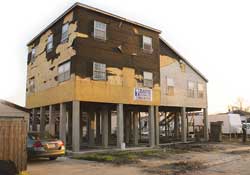The centennial observance of the Great San Francisco Earthquake and the rebuilding of New Orleans have some eerie similarities: There was total destruction in large parts of both cities from a natural disaster, the rebuilding efforts tried to prevent the same kind destruction in the future and there was a curious belief that if you prepare for a 100-year event, it somehow will not happen for 100 years.
 |
| (Photo by The Bancroft Library) |
San Francisco was destroyed at 5:13 a.m. on April 18, 1906, following a magnitude 8.3 earthquake. New Orleans was destroyed on Aug. 29, 2005 by a category three hurricane. In both cases, everyone had known for years that there was a natural danger, but in many ways ignored it.
One hundred years of seismic design advances have made San Francisco a lot safer, but some experts on the anniversary said it is only a matter of time before the city is substantially destroyed again by an earthquake. The damage largely will be the same—collapse of unreinforced masonry buildings and other structures not up to seismic code, and fire. After a century, the city still needs more time to mitigate the hazards.
At best, New Orleans has the benefit of fresh thinking and a “clean slate” as it seeks a development path that will bring a much stronger and safer level of reconstruction and more economic vitality. The Federal Emergency Management Agency pointed a flashlight in that direction on April 12 with new advisory base flood elevations. These elevations are not binding but are tied to the National Flood Insurance Program, which gives them some weight (see p. 14). According to FEMA, substantially damaged homes or businesses protected by levees should be elevated at least 3 ft, assuming that Congress funds levee and flood-control work to protect against a 100-year flood. The good part of this news is that there finally is some direction for the rebuilding. The bad news is that it does not go far enough.
 |
(Photo by Tom Sawyer for ENR) |
The old New Orleans made certain assumptions about flood protection that were unfounded and it paid the price. We agree with FEMA that building or rebuilding homes with on-grade concrete slabs is a ridiculous option in areas that had 9 ft of water. But so is elevating structures by only 3 ft. Simple arithmetic shows the potential for 6 ft of water in buildings if levees breach again. The cycle of destruction and rebuilding would begin all over—maybe in 100 years, maybe in one.
There are other practical benefits of higher elevations. If structures are raised by 3 ft, the area below is unusable, except for pets seeking shade. If they are elevated by 8 or 10 ft—as is common in many shore communities—space is created for parking, storage, recreation and other non-living purposes. When jacking an old house or building anew, make the most of it.

Post a comment to this article
Report Abusive Comment